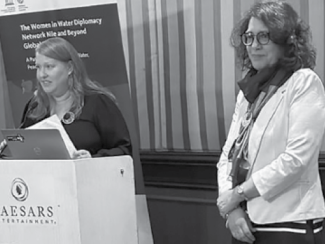In a political climate marked by polarization and division, sometimes you need a tangible reminder of how interconnected we are. For Radhika Fox, this uniter comes in the shape of one of our most important, yet underappreciated resources: water. Even when we are unable to come to terms with our interdependence, the evidence is plain to see. “If there’s somebody upstream, there’s always somebody else downstream. That’s the nature of the water cycle,” says the country’s most senior water policy official.
A day-one appointee in the Biden administration, Fox was officially sworn in as assistant administrator for water at the U.S. Environmental Protection Agency on June 16, 2021. She is the first woman of color and the first person of Asian American heritage to ever hold the position—a historic moment for the water office.
It’s also “a historic moment for water,” as Fox says. Half a year after her confirmation, the bipartisan infrastructure law injected into the economy more than $50 billion for clean water—the greatest single federal investment in water in the nation’s history. As new infrastructure funds flow through the country, all eyes are on EPA and its Office of Water to tackle some of the most complex and important issues facing this vital resource.
On the most basic level, Fox and her team’s job is to keep the nation’s surface waters clean and its drinking water safe. These Herculean tasks require implementing an alphabet soup of regulations and statutes, most importantly the federal Clean Water Act and the Safe Drinking Water Act. Policymakers at the water office draw out rules to regulate the filling of wetlands and the discharge of pollutants, among other duties.
The water team is also taking on many of the nation’s most pernicious environmental injustices, including lead, per- and polyfluoroalkyl substances, or PFAS, and other toxics in drinking water. Fox has named these issues as top priorities for her tenure. “There’s nothing more fundamental and more essential than equity in the context of water management,” she says.
“I mean, just think about your day, right? You can’t get through your day without access to clean, safe water, whether that’s having that cup of coffee or a glass of water, or being able to provide safe water for your children. Unfortunately, millions of people in this country and all around the world don’t have that fundamental, basic security,” Fox says.
Crises like the lead poisoning in Flint and Benton Harbor, Michigan, have made clear the urgent need for improved, equitable water management. Exposure to lead, particularly in drinking water, disproportionately affects low-income communities and communities of color. The contaminant impairs neural development in children and causes greater risk of kidney failure and stroke, among other health conditions. According to the White House, lead pipes run through an estimated 6 to 10 million homes, plus another 400,000 schools and child care centers.
Early on in his presidency, President Biden announced a goal to replace all lead service lines in the United States. The directive relies heavily on the Office of Water’s regulatory muscles, particularly when it comes to tightening protections under the Lead and Copper Rule, a Safe Drinking Water Act-related regulation published by EPA to limit these substances.
LCR has spun through a turnstile of revisions over the years. In December 2021, EPA announced the office would develop new revisions to the rule, to make the regulation more protective than its current version. “We had a huge, robust public engagement process last year with communities who are on the front lines of the lead crisis, tribal nations, co-regulators, and national associations,” Fox says of the upcoming rule.
In an earlier E&E News interview, Fox clarified that these roundtables would help close a crucial gap in understanding. “We know historically that we haven’t really considered enough the way in which the Lead and Copper Rule impacts people of color,” she said. EPA expects to finalize the new revisions by October 2024.
Concurrently, the water office is moving forward on policies to limit PFAS. These so-called “forever chemicals” are found in the bodies of virtually all Americans, and are associated with cancer, immune disorders, and developmental issues, among a host of other health harms. Fox co-chairs the EPA Council on PFAS, along with the agency’s Region 1 Deputy Regional Administrator Deborah Szaro. The group coordinates agency-wide efforts on PFAS according to a timeline in the council’s strategic roadmap. Targeted actions include regulating PFAS under the SDWA and minimizing chemical discharges in wastewater.
Although many of these rulemakings are still in progress, Fox says she is already “incredibly honored to be in this role as assistant administrator for water to continue the journey toward water equity and justice.” Growing up, her understanding of the disparities between communities and countries developed on an intuitive level, rather than as a conscious awakening.
“My commitment to equity and justice and opportunity for all comes from my upbringing, first and foremost. I am the child of immigrants who came to this country searching for economic opportunity, and I very much stand on their shoulders,” she says.
Fox’s parents grew up in rural India, and her grandparents worked as small farmers, growing rice, lemons, and bananas. Water was essential to her family’s agricultural livelihood. At the same time, their village lacked tap water or flush toilets; the family relied on drinking wells and pit latrines.
Her family regularly traveled back to her grandparents’ village during the summers of her childhood, an experience that allowed her to “see how infrastructure, especially water systems that we didn’t have at my grandmother’s village, can create these communities of opportunity.”
“I think equity is deeply ingrained in who I am because of my background, and from recognizing that the opportunities afforded to you are often random—like from whom and where you were born. I have always felt a desire to give back because I have been given so much opportunity by my family,” she says.
As an undergraduate student at Columbia University, Fox volunteered in Harlem and “saw firsthand how there are so many systems and structures that afford opportunity to some, but not to others.” The experience affirmed a lifelong commitment to equity and justice. Even in her earlier work on infrastructure, housing, and transportation, environmental justice served as “a thread through all of those experiences.”
Fox describes her career trajectory as “grounded in infrastructure.” After more than a decade as the federal policy director at PolicyLink, a research institute dedicated to racial and economic equity, she joined the San Francisco Public Utilities Commission as director of policy and government affairs, helping to provide water and wastewater services to more than 2.6 million Bay Area residents.
“What drew me to the SFPUC was their infrastructure work. The biggest tributary to infrastructure investment in San Francisco is actually the water department. People don’t realize that, so although I went there for infrastructure, I fell in love with working on all kinds of water issues,” Fox says.
She continued to make her mark on the water world as CEO of the national nonprofit U.S. Water Alliance. There her stature began to be generally acknowledged. “Radhika Fox is a significant figure in the water sector—a woman with tremendous respect and standing in the community,” says Tracy Mehan, former assistant administrator for water under the George W. Bush administration. At the Water Alliance, Fox worked to find common ground between water utilities, businesses, nonprofits, and other water sector stakeholders for more than five years before joining EPA.
What sets Fox apart from other bureaucrats is a grounding of policies in the lived, on-the-ground experience of everyday people. Fox has frequently mentioned in public statements that her team’s policymaking will be guided by a principle of “listening to all sides to find enduring solutions.” The philosophy has been a “through line” in her career, and will be put to the ultimate test for reaching consensus on one of water’s most contentious policy issues—the Waters of the United States rule.
Under written law, Clean Water Act jurisdiction extends to any area designated as “Waters of the United States.” What exactly these include is something policymakers have failed to achieve consensus on since the 1980s. A confusing definition of WOTUS jeopardizes the ability of governments at every level to protect the nation’s waters, for a simple reason—whatever doesn’t count, doesn’t get regulated under the federal law.
One sticking point is whether ephemeral or intermittent streams should be covered. The issue has significant implications for the arid Southwest, where water levels tend to fluctuate much more than other areas of the United States. Relentless back-and-forth between administrations, and court decisions over the decades that have introduced even more confusion, has left a patchwork of jurisdictional definitions operating in the country.
Fox describes the last decade of the WOTUS debacle as a “constant ping-pong.” In 2015, the Obama administration issued a Clean Water Rule to define WOTUS. That definition was later rescinded by the Trump administration and replaced with the Navigable Waters Protection Rule in 2020, a regulation that High Country News said would potentially “exclude as many as 94 percent of Arizona’s and 66 percent of California’s streams and rivers from federal oversight, depending on how regulators interpret it.” The rule was eventually vacated by a federal district court in Arizona in 2021.
Overhauling WOTUS is a focal point for Fox’s tenure in the Office of Water. In her Senate confirmation hearing, Fox affirmed, “Administrator [Michael] Regan and I want an enduring definition of Waters of the U.S., one that can withstand administration changes.” So far, the agency has initiated a two-part rulemaking process that first restores a version of the pre-2015 WOTUS definition. Next, the office will establish a brand new definition, potentially settling the matter once and for all.
Establishing a lasting rule won’t be easy. In a podcast interview with Fox, David Ross, the former assistant administrator for water under the Trump administration, delivers brief advice that sounds more like an inside joke: “I’m just going to say: ‘Good luck.’”
Fox and her team have committed to a system of robust public engagement to guide the office’s decisionmaking. The process involves a series of stakeholder meetings and 10 regional roundtables to be held over the coming spring and summer. Roundtable discussions will include representatives from water and wastewater service providers, agriculture, environmental justice communities, tribal nations, and state and local governments, among other groups.
“It’s an issue where there is so much division. What we have been focused on is: how do we get to a durable definition of waters of the United States, one that tries to balance the very diverse perspectives that have a stake in this definition? I believe that we’re not going to be able to do that unless we listen to all sides,” she says.
Believing that different sides can reach consensus feels radical nowadays, especially in a country with as entrenched social and political chasms as the United States. But Fox believes in the power of hearing from someone you may have never otherwise crossed paths with—and she’s seen it in practice.
In her first year as CEO of the U.S. Water Alliance, Fox helped create the Water Equity Network, a program that guides utilities in building equitable water systems. The idea was borne from a desire to act on the severe human health issues faced in the Flint water crisis and beyond, as well as lessons learned at the San Francisco Public Utilities Commission.
“My experience at the SFPUC proved that water agencies can be community anchor institutions. We were the first utility in the nation to adopt a community benefits and environmental justice policy, and I saw how water agencies are fundamental to the solution,” she says. The organization invited cities like Atlanta, Buffalo, Cleveland, Camden, Milwaukee, and Pittsburgh, among others to participate. It gathered water agencies, local officials, and frontline community organizations most impacted by water-related challenges—including lead, contaminated water, PFAS, and flooding—and forced everybody to listen to all sides.
“The water managers—these technical leaders—heard firsthand from people whose water had been shut off. They learned what that meant for them, and what that meant for their children. These were people who had their basements flooded, and were just living in conditions that no one should have to live in,” she recounts. “The water managers heard directly from those communities, and in turn, the communities heard about the constraints that water managers face. There were so many breakthrough solutions that happened because we created a space for a deliberate, thoughtful airing of all of the issues.”
To Fox, public engagement is not just a box to be checked off. She believes that centering these lived experiences strengthens decisionmaking in a substantial way. “When we listen to all sides—when we embrace the complexity of the issues that we’re tackling in the water sector—we can actually reach better outcomes because of that listening. It leads to a different set of solutions,” she says. “That’s why this principle is so foundational to how I think about the work that I do every day."
Fox's leadership, woven with a philosophy that aligns with the Biden administration’s investments in environmental justice, comes at an opportune time. Yet the choice is deliberate: diversity within the country’s top political officials is a minimum requirement for more representative, people-first policies. As Fox puts it in a Politico interview, “I think selecting somebody like me—frankly, as a woman of color in this leadership role—is also part of the Biden-Harris commitment to building a federal team that reflects the diversity of this nation.”
In the coming years, the Office of Water’s responsibilities will only grow, particularly when it comes to ensuring that new funds under the bipartisan infrastructure law go to those who need it most. About 85 percent of those funds will flow through State Revolving Funds, or SRFs, the main channel for distributing money for water infrastructure and projects. The infrastructure law mandates that 49 percent of this money must go to disadvantaged communities as grants and forgivable loans. But what exactly constitutes a disadvantaged community is under the discretion of states.
On March 8, the water office released a 56-page memo to state SRF program managers and EPA regional water division directors to provide guidance on stewarding these funds and clarify responsibilities states have to disadvantaged communities. “The memo encourages states to look at their definition of disadvantaged communities to make sure it’s consistent with statutes, and provides guidance on preferred factors that should be considered when making the investments in disadvantaged communities,” Fox says.
“The water sector can and must do better to steer all kinds of investments, whether it’s the bipartisan infrastructure law money or other infrastructure funding programs, to these communities,” she says. “With so much money on the table, and so many challenges that we see around the country, I think this is the moment to meet the needs of all communities.”
She emphasizes that the memo is only the first step in EPA’s work to ensure that the historic investments in water don’t leave anyone behind. “One exciting thing that is coming later this year is a very robust technical assistance strategy to help disadvantaged communities build their technical, financial, and managerial capacity to receive these funds. We’re quite excited to work with states, tribes, and territories in that next phase.”
This year marks the 50th anniversary of the Clean Water Act, a law passed during a time when rivers caught on fire from unchecked pollution. Fox says there is still much work to be done. Today, many of the most insidious water issues are invisible, even though their effects may not be. Millions of Americans depend on the work of the Office of Water and its ongoing rulemakings. The stakes are high, and so is the pressure on Fox’s team.
Nonetheless, Fox’s optimism remains grounded in the importance of this work, and the power of water to connect us.
“I think that one of our foundational principles as a nation should be to recognize that water is essential to everyone—to every business, to every community, to every person, and to use that as our north star as we develop future policies.” TEF




